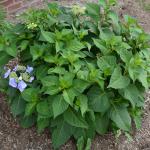Why Hydranagea macrophylla Don’t Flower
Hydrangea macrophylla, commonly referred to as bigleaf hydrangea, is one of the most popular landscape shrubs owing to its large mophead flowers. Although it does not have any serious insect or disease problems, Hydrangea macrophylla can be a challenging shrub for those looking for prolific and consistent blooms every year. This is due to the number of factors that can affect Hydrangea macrophylla blooms over the course of the year. Some of these factors are simple mistakes that happen at planting or during maintenance while others are the result of environmental factors that are out of our control.
Planting and Maintenance Mistakes
- Improper pruning is one of the most common reasons Hydrangea macrophylla don’t bloom. Older cultivars bloom on “old wood” which means that flower buds develop on the stems during the summer the year before they bloom. Newer cultivars have been bred to bloom on both new and old wood meaning buds develop on both the current and past season’s growth. Pruning should be done in the spring as new growth resumes and healthy, living branches can be determined from dead branches which can be removed. Keep in mind even with the newer cultivars that bloom on both new and old growth that the majority of blooms occur on old wood.
- Incorrect sun exposure. Bigleaf hydrangea prefers morning sun and dappled afternoon sun or part shade. Too much shade will reduce flowers, but too much afternoon sun will lead to plant stress.
- Inadequate moisture. Plants need well-drained soil with good moisture for best growth. Drought stress can impact blooming, and overall plant health, even if leaves look fine. However, there is such a thing as too much of a good thing, as over-watering can also reduce plant health and flowering.
- Over-application of fertilizer. Too much nitrogen fertilizer promotes deep green leaves but few flowers. Keep in mind that sometimes this can be due to fertilizer from other areas of the yard washing into the soil surrounding the Hydrangea. Fertilizers higher in phosphorus rather than nitrogen encourage bloom growth.
- Also keep in mind that new plants need time to establish. During establishment, which is generally considered the first growing season, plants are working on root growth and stem development and may not flower as much.
Environmental Factors
- Winter damage is unfortunately very common with bigleaf hydrangea. Hydrangea macrophylla are cold hardy to Zone 6 and need to be protected when grown in Zone 5. Some cultivars are more cold hardy than others, offering hardiness to Zone 4. But even more cold hardy cultivars can commonly have winter damage. Winter weather can damage hydrangea buds due to low temperatures, fluctuating temperatures, and late frost or freeze events.
- Cold spring temperatures or late freeze events can also result in delayed or damaged spring growth.
- Cooler summer temperatures can also reduce blooms or delay blooming.
- Drought can also affect flowering. If a drought is severe it can affect flowers in subsequent years after the drought.
Wrapping plants by creating a cylinder using burlap or chicken wire and stakes that is then filled with leaves or straw can help protect hydrangeas during winter (see Fig. 1 above). However, in particularly harsh years, plants will likely die back to the ground or will not bloom despite protective measures. Probably the most difficult thing for many people is that, even with proper planting in the correct location, there will be years that a Hydrangea macrophylla will not bloom because of unfavorable winter (or spring) conditions. It can also be frustrating when repeat blooming cultivars don’t bloom as anticipated. For those determined to consistently have Hydrangea blooms year after year, or would like a Hydrangea in a challenging area, Hydrangea paniculata may be a better selection. Of course, for those that desire blue or lacecap flowers, Hydrangea paniculata will not be a good substitute. Regardless of the challenges with flowering, Hydrangea macrophylla remains a landscape favorite and, for many, are worth the wait for the blooms.



